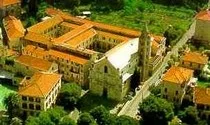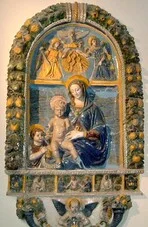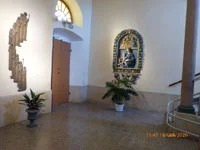Madonna and Child with Saint John the Baptist
Documents
1-MADONNA WITH THE CHILD AND LITTLE JOHN THE BAPTIST
(click on the photos)
The founders of this monastery came from Tuscany (Monte Oliveto near Siena), therefore it is understandable that they brought to Finalpia some artistic techniques typical of that region, such as these three specimens of the Della Robbia school (first half of the 16th century).
These Robbiane are all the more popular as they are the only ones in all of Liguria.
1-The Mother with the Child and Giovannino (near the staircase leading to the 1st floor)
The group is currently located in the staircase, near the door that leads into the first cloister.
During five centuries, however, it has found different locations, even on the upper floor.
In the wall, where this group is inserted, a door opened (up to the 1950s) which led to the hall of the First cloister.
The soil of the cloister arcades had remained for centuries (until the 1950s) in beaten earth and the monks could thus go down from the dormitory to the first floor and then pass, through successive internal doors, from the refectory, to the church without having to go through the cloisters.
In this way they avoided muddying their shoes in case of bad weather: in addition to their personal decor, the cleaning of the floors of the church and the monastery was worth it.
Of the three Robbians, this is perhaps the most precious, but also the most damaged.
There are experts who see the hand of Giovanni della Robbia himself and not only a product of his workshop: the face of the Madonna reveals the touch of an artist (not of a workshop worker, more than anything else intent on reproducing in series the most requested works).
The greatest damages concern the Child Jesus, who has been beheaded and has some damaged limbs. (Those who then tried to remedy, by making a new head for the Child, revealed a lot of goodwill, but not a touch of an artist).
Furthermore, to the little s. John the Baptist was scarred on the face.
NOTE. Between 1800 and 1900 these rooms hosted the elementary schools of the Municipality of Finalpia and it is probable that the most discreet among the schoolchildren of the time, took advantage of it to practice an atrocious ante litteram bullying on these two children of the Robbiano group.
There are also those who put forward a hypothesis about the beheading of the statue of the baby Jesus ...
The head (probably of considerable artistic value) would have been carefully removed (or had it removed, on commission) by someone who wanted it all for himself, or to trade it. Not a rare and well-known case, for those interested in art.
But let's come to our group, trying to appreciate the values that are still being found there.
The whole stands out for its remarkable development in height (m. 2.20) and for its various joints - or, as we say with the technical term, for its "registers".
The group is made up of four registers:
-in the first at the top (arched), with two angels flanking the Dove (symbol of the Holy Spirit), from which flames of fire branch out towards the bottom;
- in the second register (below the previous and larger one) there is the seated Madonna, with the baby Jesus on her knees and on her feet the little s. John the Baptist.
-the third register is longitudinal, with the scene of Christ in the tomb in the center, flanked by figures of Saints (the Madonna on the left and St. John the Apostle on the right). On the sides of the central scene: there is S. Benedict, left and S. Bernardo Tolomei, the founder of the Olivetan monks, on the right.
At the two ends of this register the Olivetan Coat of Arms is repeated: three mountains, the Cross and the olive trees.
- the fourth register at the bottom, with the function of closing, shows in the center an angel that flaunts the Olivetan symbol with open hands; on the sides of this angel, two cornucopias overflowing with fruit and greenery, form the final frame of the group.
Finally, it should be noted that this specimen is the richest in ornamental elements with a vegetable festoon loaded with fruits and foliage which gives a note of naturalistic liveliness to the whole. Furthermore, the coat of arms of the Olivetan Benedictine Congregation (founder of the monastery) with the three mountains, the Cross and the olive trees, recalling the Garden of Olives of the Lord's Passion, is repeated three times.
This group was evidently commissioned by those who cared for it to stand out that it was a Madonna for a monastery of Olivetan monks: and who knows if it was not Fra 'Angelo di Albenga himself who took the initiative?
The date (1522, approximately) of the work would correspond precisely to the first priory (1518-1523) of the young young Prior.



